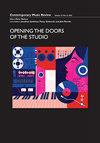技术过时的导航——Stockhausen的Mikrophonie I的分析与重建
IF 0.3
2区 艺术学
0 MUSIC
引用次数: 0
摘要
本文概述了Karlheinz Stockhausen的六重奏Mikrophonie I(1964)的制备和解释方法。这项工作的潜在表演者面临着重大的可访问性问题:斯托克豪森推荐的设备——尤其是用于处理塔姆声音的电子滤波器——极为罕见。这些问题往往需要执行人员为设备找到替代解决方案。Mikrophonie I是带电电子产品的几个作品之一,由于执行这些作品所需的技术过时,这些作品变得越来越难以编程。表演者经常使用Max/MSP等软件以数字方式重建必要的电子设备。Wetzel[(2006),“交互式电声剧目的保存模型:面对技术过时的分析、重建和表现”,《有组织的声音》11(3):273-284。https://doi.org/10.1017/S1355771806001555]描述了这一重建过程的三阶段模型,该模型强调了表演者主导分析的必要性。以Mikrophonie I为案例研究,我扩展了Wetzel的模型,通过两个主要的分析视角来引导重建:声音或过程的优先顺序。然后将这些方法应用于我对Mikrophonie I的实现过程。我描述了基于Christopher Burns创建的补丁在Max/MSP中构建数字滤波器的过程[(2002)。“实现Lucier和Stockhausen:电声音乐表演实践中的案例研究”。《新音乐研究杂志》31(1):59–68。https://doi.org/10.1076/jnmr.31.1.59.8104]并比较用于在性能上使用过滤器的不同接口选项。参考斯托克豪森合奏团(1965年)和打击乐合奏团红鱼蓝鱼(2014年)之前的录音,我展示了创造性的诠释如何帮助合奏团克服现有塔姆的不足。除了重建表演Mikrophonie I所需的技术的细节之外,本文还强调了分析对于专门从事过时技术作品的表演者来说是不可或缺的。本文章由计算机程序翻译,如有差异,请以英文原文为准。
Navigating Technological Obsolescence: Analysis and Reconstruction of Stockhausen’s Mikrophonie I
This article outlines analytical methods for preparing and interpreting Karlheinz Stockhausen’s sextet Mikrophonie I (1964) for tam-tam and electronics. Would-be performers of this work face significant accessibility issues: Stockhausen’s recommended equipment—especially the electronic filter used to process the tam-tam’s sound—is extremely rare. These issues often necessitate performers finding alternative solutions for equipment. Mikrophonie I is one of several works for live electronics that have become increasingly difficult to program, due to the obsolescence of the technology required to perform them. Performers often reconstruct the necessary electronics digitally, using software such as Max/MSP. Wetzel [(2006). “A Model for the Conservation of Interactive Electroacoustic Repertoire: Analysis, Reconstruction, and Performance in the Face of Technological Obsolescence.” Organised Sound 11 (3): 273–284. https://doi.org/10.1017/S1355771806001555] describes a three-stage model for this reconstructive process that foregrounds the need for performer-led analysis. Using Mikrophonie I as a case study, I expand on Wetzel’s model to navigate the reconstruction through two main analytical perspectives: the prioritisation of sound or process. These methods are then applied to my realisation process of Mikrophonie I. I describe the process of constructing a digital filter in Max/MSP based on a patch created by Christopher Burns [(2002). “Realizing Lucier and Stockhausen: Case Studies in the Performance Practice of Electroacoustic Music.” Journal of New Music Research 31 (1): 59–68. https://doi.org/10.1076/jnmr.31.1.59.8104] and compare different interface options for using the filter in performance. Referring to previous recordings by the Stockhausen Ensemble (1965) and the percussion ensemble red fish blue fish (2014), I show how creative interpretations can help ensembles overcome the perceived shortcomings of their available tam-tam. Beyond the specifics of reconstructing the technology required for performing Mikrophonie I, this article underlines the indispensability of analysis for performers who specialise in works with obsolescent technology.
求助全文
通过发布文献求助,成功后即可免费获取论文全文。
去求助
来源期刊

Contemporary Music Review
MUSIC-
CiteScore
1.00
自引率
25.00%
发文量
48
期刊介绍:
Contemporary Music Review provides a forum for musicians and musicologists to discuss recent musical currents in both breadth and depth. The main concern of the journal is the critical study of music today in all its aspects—its techniques of performance and composition, texts and contexts, aesthetics, technologies, and relationships with other disciplines and currents of thought. The journal may also serve as a vehicle to communicate documentary materials, interviews, and other items of interest to contemporary music scholars. All articles are subjected to rigorous peer review before publication. Proposals for themed issues are welcomed.
 求助内容:
求助内容: 应助结果提醒方式:
应助结果提醒方式:


